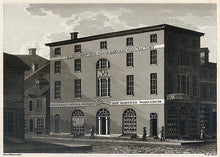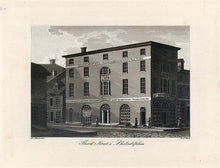Axel Leonhard Klinckowström. "Third Street i Philadelphia." From Atlas til Friherre Klinkowströms Bref om de Forenta Staterne.
Stockholm: Tryckeriet, 1824. Aquatint by Carl Frederik Akrell. 4 3/4 x 7 (image) plus margins. Very good condition.
Baron Axel Leonhard Klinckowström (1775-1837) was a Swedish aristocrat who spent the years 1818 to 1820 in America as a representative of his government. He wrote a fascinating book about his travels in America, Bref om de Forente Staterne, published by C. Muller in Stockholm in 1824, which was accompanied by an atlas of maps and prints that included nineteen views of New York, Washington and Philadelphia. The prints were beautifully aquatinted by Akrell, and their high quality bespeaks a sophisticated intended audience. While his use of aquatint to copy well known engravings provided a lovely and finished interpretation of American prints, his original pictures of New York City are considered original prints after his own paintings (Deak Picturing America, #s 310 and 322).
Although some of his Philadelphia views are thought to have been copied from William and Thomas Birch, this view of the "Mr. Kensie" saddlery and coach-harness manufactory at 39 3rd Street is original to Klinckowström. (Lane & Cresswell, Prints of Philadelphia #57, Phillips, Maps and Views of Philadelphia, #392). "Kensie" is Edmund (or Edmond) Kinsey, a saddler whose business was at the northwest corner of 3rd and Chestnut Streets at this time period, and who was a leader in 1817 of the "Philadelphia Society for the Promotion of American Manufacturers." This four storied building served for retail and wholesale trade, warehousing, and manufacturing. It was unusual for a series of city views of this period to include an image of a commercial establishment. This is an early view of a business structure in Philadelphia.





